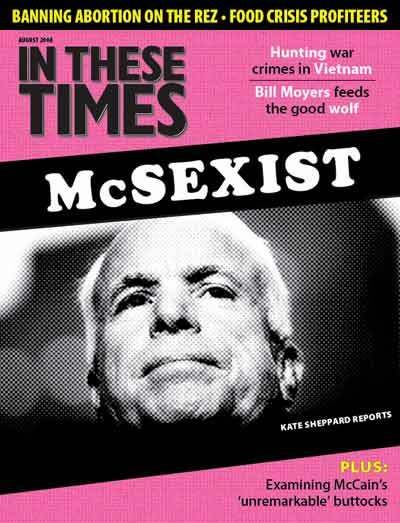
For those of us who have flirted with a life in academia, Marc Bousquet’s How the University Works: Higher Education and the Low-Wage Nation (NYU Press, January 2008) may help explain why so many of us dumped the love affair before it ever began.
In his trenchant critique, Bousquet, an associate professor of English at Santa Clara University and a major figure in the academic labor movement, sheds light on the deteriorating conditions of ivory-tower life and the American university system.
The statistics he collects are alarming. For example, between 1975 and 1995, while undergraduate admissions expanded greatly, the ranks of full-time faculty dwindled by 10 percent. During the same period, nearly 40 percent more graduate-student employees hit the scene. As a result, three out of four college teachers today lack the security of tenure. One generation ago, this ratio was reversed, Bousquet notes.
In competitive fields, as few as one in three Ph.D. holders can expect to eventually find tenure-track employment, writes Bousquet. And when they do, it’s often after longer and longer periods of low-wage, non-tenurable work.
In other words, more and more doctorate holders teach one class at a time wherever they can, for meager pay and no benefits.
Many of these professional adjuncts are scattered among several campuses and institutions, allocating as much time traveling to and from classes as actually teaching. Many lack so much as a phone or a desk, not to mention the time to pursue research and writing.
Despite the across-the-board reduction in university spending on the professoriate, tuition around the nation rose by a whopping 38 percent between 2000 and 2005. Where is the money going if not toward these education providers?
Most notably, Bousquet writes, it has gone to administrators, whose ranks have swelled as the profit motive has taken hold; to new sports and cultural facilities; and to high-profile sports coaches, who, Bousquet notes, “are often the highest-paid public employees in their states.”
In New Jersey, the highest-paid public employee is Rutgers head football coach Greg Schiano, who grossed nearly $1.8 million in 2007, including an $800,000 interest-free home loan that the university agreed to pay for, according to a February 2008 article in the local Courier-Post newspaper. Schiano amassed this exorbitant salary while other sports programs – not to mention courses and academic resources – continue to be slashed.
Rather than merely presenting such troubling statistics, Bousquet gives readers a Marxist analysis of the university’s move toward market fundamentalism. This has created the “managed university,” Bousquet writes, where socially beneficial activities have been converted to commodity form. The managed university is less interested in the “cultivation of a knowledge commons” than in the transaction, or the “sale of information goods” to prospective students.
As knowledge itself has become less important, so too has the idea of hiring the people most qualified to impart – and inspire – knowledge, Bousquet argues. Today, the university simply hires the cheapest available academic labor. That most often takes the form of graduate students, who are among the only people who can afford to teach at such low rates because they need the larger reward: a Ph.D.
Ironically enough, because of this very system, a doctorate degree becomes close to worthless, and its holders become what Bousquet calls “the waste product of graduate education.”
In an interesting wrinkle, Bousquet traces the ways in which existing faculty and their unions have contributed to this system – whether by acquiescing to the commodification of research and intellectual property, or by continuing to label graduate-student employees as “students” and not “workers.” He rightly notes that many faculty members, faced with administrative threats to their own autonomy and livelihoods, are content to get what they can in the broken system rather than fight to fix it. Thus, collective bargaining by full-time faculty becomes what Portland State University professor Johanna Brenner calls a “survivor project” – and what Bousquet says “fall[s] far short of the ideal of worker solidarity against exploitation.”
With the failure of faculty to affect systemic change, Bousquet sees graduate student employees and other contingent faculty as the last great hope. “They know they are not merely treated like waste, but, in fact, are the actual shit of the system,” he writes, “not merely ‘disposable’ labor but labor that must be disposed of for the system to work.”
The movement to organize graduate-student employees has been around since the ’70s but has intensified in the last decade with high-profile battles at a few elite private universities like New York University (NYU) and Yale.
NYU grad students, in particular, have had a roller-coaster ride, as detailed in The University Against Itself: The NYU Strike and the Future of the Academic Workplace (Temple University Press, February 2008), a collection edited by Monika Krause, Mary Nolan, Michael Palm and Andrew Ross.
Their book combines on-the-ground reportage and thoughtful analysis to provide essential reading on the worker struggles at NYU and the broader academic labor environment.
In April 2000, Daniel Silverman, National Labor Relations Board (NLRB) regional director, found that NYU’s teaching assistants were in fact employees, and that the services they provided for NYU were not “simply part of their education.”
Within six months, the full NLRB upheld the earlier decision after hearing an appeal from NYU. The United Auto Workers (UAW), acting as the bargaining agent for the Graduate Student Organizing Committee (GSOC), later negotiated what Bousquet calls “one of the best graduate-employee contracts ever.”
But between the time that the NLRB ruled in favor of the graduate students, and the time NYU and the UAW ratified the new contract, the first steps toward a rollback had begun.
George W. Bush became president and his anti-labor ideology would soon come to bear on graduate-student employees. In January 2002, Bush made two recess appointments to the NLRB, giving it a Republican majority. Then in 2004, in considering the rights of the UAW to represent student employees at Brown University, the NLRB ruled that the relationship between graduate-student employees and an institution “is primarily educational.” In the decision, the board also said, bluntly: “NYU was wrongly decided and should be overruled.”
In June 2005, NYU announced it had no intention of negotiating a second contract with the GSOC. That November, the student employees and their allies began a strike.
The University Against Itself is strongest when it provides a behind-the-scenes look at what went down during the strike. In that sense, the book reads like a rebuttal to the flawed and often pro-administration mainstream news reporting on the action.
Susan Valentine’s piece, for instance, describes the way the university struck back. The GSOC spokesperson during the strike notes that little more than a month after walking off the job, NYU’s president told striking workers that they would be fired for the next semester if they didn’t return to work within the next week. He also threatened to remove them from their jobs the following semester if they extended the strike another semester.
“The threat of losing our livelihoods for up to one year had an immediate chilling effect, just as intended,” Valentine writes. In most other labor environments, this kind of behavior by an employer would have been illegal – but because the NLRB had ruled that grad-student employees were primarily “students,” NYU could act ruthlessly and with impunity.
Valentine also takes a look at the less apparent way the administration retaliated: through disinformation. “Facts were distorted … to make grads’ own fight for self-determination into meddling by ‘autoworkers,’ ” with NYU constantly griping about the UAW’s “interference in academic affairs,” she writes.
The university, with its institutional power, was also able redefine language to control the strike. Thus, graduate-student employees’ wages, which are often earned for doing research or teaching undergraduates, became “financial-aid packages” rather than “wages” or even a “salary” – making graduate employees appear more like students and less like workers.
The student employees ended the strike in May 2006 – without a contract. Even so, the book’s editors conclude that the action wasn’t an outright failure because it prompted “widespread reflection on the changing character of the 21st-century university.”
Reading Bousquet, one senses he would agree with that characterization. In that regard, the NYU strike should be seen as the necessary first step toward separating the university from our pervasive corporate culture.

I hope you found this article important. Before you leave, I want to ask you to consider supporting our work with a donation. In These Times needs readers like you to help sustain our mission. We don’t depend on—or want—corporate advertising or deep-pocketed billionaires to fund our journalism. We’re supported by you, the reader, so we can focus on covering the issues that matter most to the progressive movement without fear or compromise.
Our work isn’t hidden behind a paywall because of people like you who support our journalism. We want to keep it that way. If you value the work we do and the movements we cover, please consider donating to In These Times.




